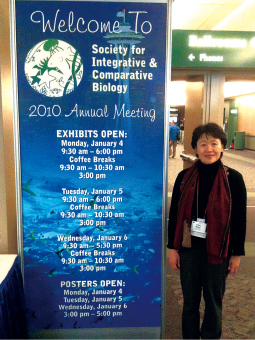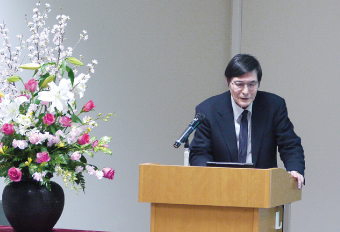
Yuko Nagai
(Secretary-General, The Zoological Society of Japan; Director, UniBio Press)
 SICB Meeting at Seattle,U.S.A.
SICB Meeting at Seattle,U.S.A.
The Society for Integrative and Comparative Biology (SICB) was formerly the American Society of Zoologists. When it changed its name in 1996, its journal American Zoologist was also renamed, becoming Integrative and Comparative Biology (now published by Oxford University Press). In other words, the SICB is the Zoological society of the United States; oddly enough, it is approximately the same size as the Zoological Society of Japan, with about 2,400 members.
On January 2, I was in Seattle, Washington, to promote the six journals of UniBio Press at the SICB’s 2010 Annual Meeting. Half my travel and other expenses were paid by SPARC Japan. I had long wanted to attend SICB because I believe it is important for Japanese academic societies to promote their journals to potential authors, and SICB draws researchers who are good potential contributors to the UniBio journals. Budgetary and other issues are admittedly a problem, but the exhibitor fee to rent a booth for three days was a mere $250 for a nonprofit group ($900 for profit-making organizations).
I engaged visitors to the booth in conversation, asking, for example, “Do you happen to know any of these Japanese biology journals?,” “Do you know about the work of SPARC?,” and “What are your criteria when you choose where to submit a paper?” I spoke with more than 150 researchers and students over the three days. Quoted below are some typical comments that I think shed light on how Japanese journals are perceived:
- Are they in English?
- I know some of them well, but I don’t know where to find them online. (On being told that they are at BioOne) I didn’t know that, even though my university subscribes to BioOne. I had no idea.
- I read this journal often. One reason is that I am doing joint research with someone who is on its editorial board. I have contributed to it myself.
- Since I’m working on a particular animal which is found in Japan, the mamushi (pit viper), there are many articles I want to read but can’t, as they are mostly in Japanese. I depend on this journal a great deal as it is in English.
- When I got back to my lab yesterday, I tried accessing the journals shown on the tote bag you gave me, and found that we already subscribe and I could read the articles. I wasn’t aware that there are journals in Japan publishing such interesting work. Thanks for letting me know.
- I am interested in Japan’s journals, but their IFs are relatively low. In Korea, it’s important to publish in a journal with a high IF, and that makes it difficult to submit papers to Japanese journals.
- I don’t think of Japanese journals as a separate category, but I’m not familiar with the journals you have here.
- I read a lot of papers by Japanese researchers, but I don’t know whether the journals they’re in are published in Japan.
I was very happy to meet people who knew the UniBio journals, but I also felt the need to get the word out about the individual societies’ journals, including the fact that they can be accessed on BioOne. In this era of package marketing, when a researcher chooses where to submit a paper, the journal’s name recognition and IF are important, but for a journal that remains little known, it is becoming all the more of a challenge to bring itself to readers’ attention and encourage submissions, because journal contents are now accessed in the form of individual articles. The idea that not charging for access would raise a journal’s name recognition was a myth; that has now become clear. Based on my conversations at SICB, I see the primary task for Japanese journals as to emerge from obscurity and make themselves visible. Lastly, I would like to thank SPARC Japan for making it possible for me to attend the SICB Annual Meeting; I hope to put the information and experience I obtained there to good use in journal publishing in the future. I would also like to thank the Zoological Society of Japan, a society with a long history which, as it happens, is my employer, for encouraging me to attend and for the Board’s decision to cover half the expenses in order to help promote Japan’s biology journals, including their own.


SICB Meeting at Seattle,U.S.A.
On Tuesday, March 9, 2010, Prof. Masamitsu Negishi, who has served as a member of SPARC Japan’s Steering Committee since its inception in FY 2003 and as its chairperson since FY 2006, gave a farewell lecture to mark his retirement from the NII. In a sequel to his talk “Bibliometric Indices for Evaluating Research and Journals: Present Status and Issues” at the 6th SPARC Japan Seminar 2008, he proposed an adjustment to the Impact Factor (IF) resulting in a new index, the Impact Deviation Value (IDV). Prof. Negishi will present a more detailed report at the 18th (2010) Annual Meeting of the Japan Society of Information and Knowledge (May 15–16, 2010, Faculty of Engineering Building 2, Hongo Campus, University of Tokyo; http://www.jsik.jp)

| Date |
Topic |
| 2010 |
Wed.,
June 23 |
1st SPARC Japan Seminar 2010
“Work and Management of Academic Societies” |
| Aug. |
2nd SPARC Japan Seminar 2010
“How To provide the service of EJ” |
Thurs.,
Sept. 16 |
3rd SPARC Japan Seminar 2010
“Towards a Digital Mathematics Library” (RIMS Workshop) |
Fri.,
Sept. 24 |
4th SPARC Japan Seminar 2010
“A Look Ahead to the Next Decade of Scholarly Communications in Japan”
(81st Annual Meeting of the Zoological Society of Japan) |
| Oct. |
5th SPARC Japan Seminar 2010
“Open Access Disseminated from Japan”
Open Access Week (Oct. 18–24) |
| Nov. |
6th SPARC Japan Seminar 2010
“The Harvard Open Access Policies”
(Library Fair & Forum) |
| 2011 |
| Jan. |
7th SPARC Japan Seminar 2010
“Author IDs: Recent Developments” |
For the latest news of events, see the SPARC Japan website: http://www.nii.ac.jp/sparc/en/event/ |

